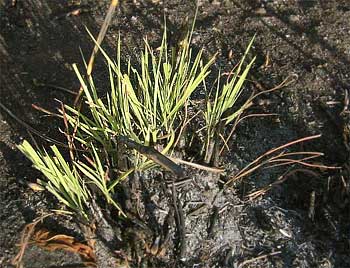Excerpts from Jim Conrad's
Naturalist Newsletter
from the March 24, 2008 Newsletter written in the community of 28 de Junio, in the Central Valley 8 kms west of Pujiltic, elev. ~700m (2300ft), ~N16.331°, ~W92.472°; southeastern Chiapas state, MÉXICO
DRY-SEASON SLOPE-BURNING
Just about everywhere in Mexico where farmers tend land on slopes they're burning their fields at this time of year. Sometimes the number of fires and the amount of smoke spreading across the landscape is hard to believe.
Seasonal burning has roots in slash-and-burn farming practiced in antiquity. A forest plot was cut, or slashed, and burned. The first crop on the newly exposed soil was tremendous because nutrients in the forest's charred remains enriched the soil, and weeds, insects and diseases hadn't infested the plot yet. But the next year fewer nutrients were available and weeds, insects and diseases were starting to invade. After maybe five to ten years conditions will have deteriorated to the point where the plot would be abandoned. Then the forest would gradually return as the soil reestablished its nutrient load and regained its former texture, and eventually the plot would be slashed and burned again.
Slash-and-burn served the ancient Maya well when their population density was low. As human numbers increased, however, resting time between slashings diminished, until today there's no resting time at all -- just yearly dry-season burning on an ever-deteriorating soil.
Farmers say that seasonal burning enriches the soil and to prove it they point to tender, succulent, green sprouts that emerge soon after burning, as shown below.

But, each time a field is burned, cinderized plant bulk that should have decomposed naturally and contributed spongy, nutrient-absorbing organic matter to be mixed into the soil by earthworms is washed downstream as ashes and nutrients in solution. Even the soil's exposed mineral part washes downstream to clog reservoirs.
On seasonally burned slopes rocks gradually emerge from the soil like bones from a wasting body. Slowly what once was a diverse ecosystem soaking up and holding rainwater like a sponge becomes exposed rock and hard-baked dirt on which extremes of temperature and water availability, and lack of available nutrients makes life hard to impossible even for simple forms of life.
My experience is that you can't convince farmers here that burning, in the long term, hurts the land. Those tender, succulent, green sprouts emerging soon after burning is all the proof they need that their burning does its job of revitalizing the land.